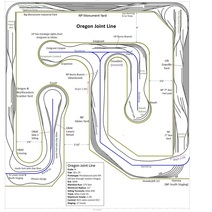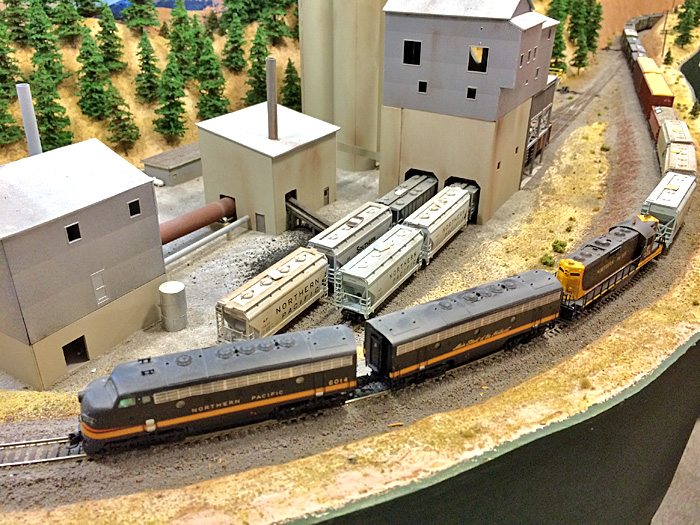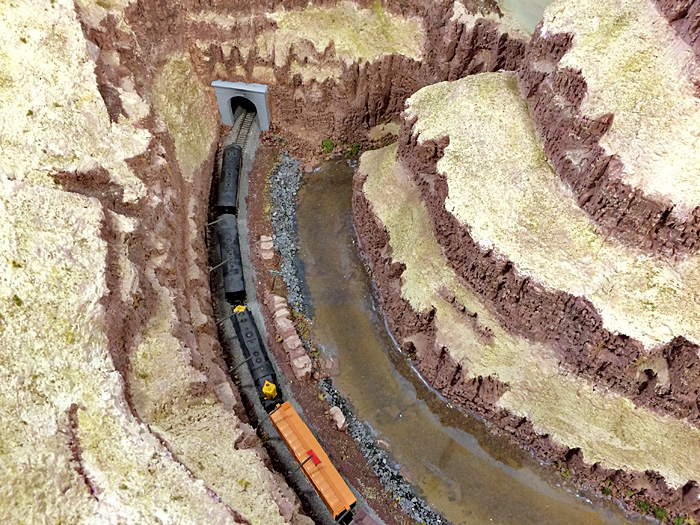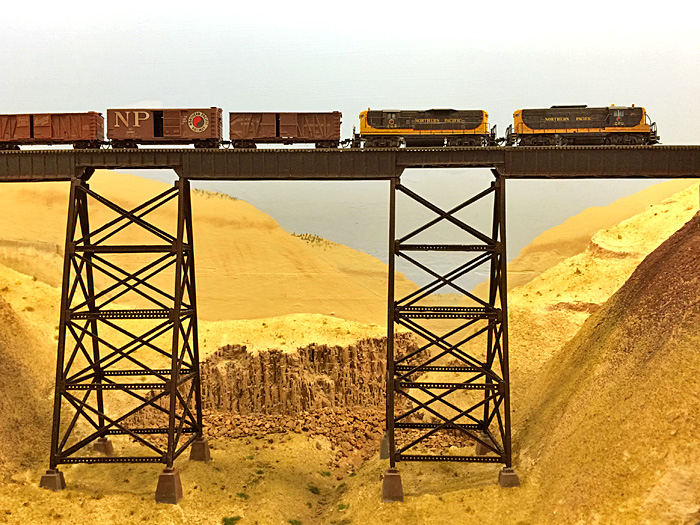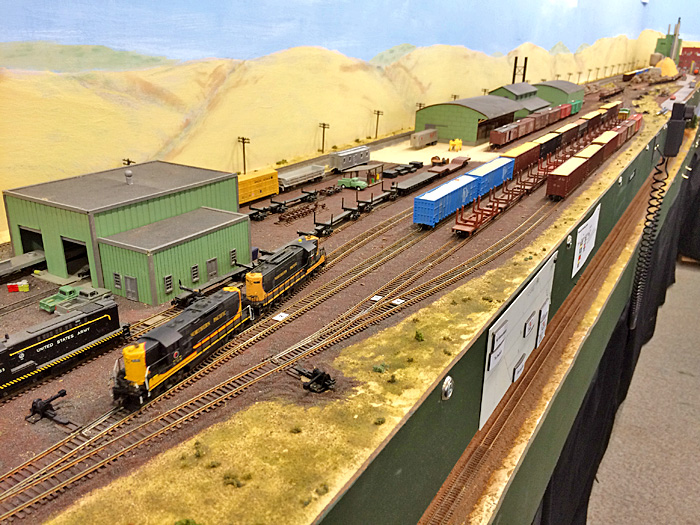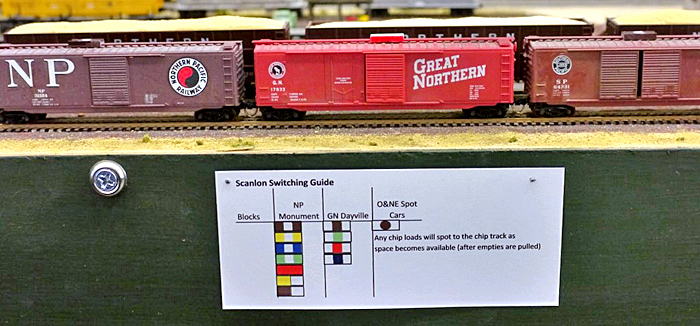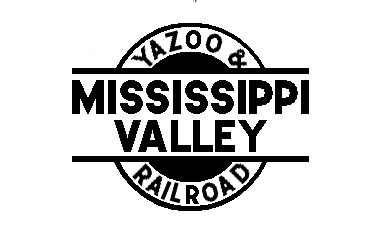Northern Pacific Oregon Joint Line
|
|
1st Slide Show - Adventures of NP Train No. 664
Dean Ferris hosted an operating session on his N-scale Northern Pacific "Proto-Freelanced" 1969 Northern Pacific joint line through eastern Oregon. This railroad features joint operations with the Great Northern and sports run-through power of the Rio Grande, Santa Fe, Southern Pacific and Western Pacific in addition to NP and GN power. The layout measures 28 feet by 25 feet with 275 feet of mainline and a minimum curve radius of 22 inches. Siding turnouts are Atlas No. 10 switches and Atlas Code 55 rail is the norm. The ruling grade is 2.2% southbound from Dayville to the summit at Snowline. The northbound grade from Silvies to Snowline is 1.8%. Heavy tonnage trains require manned helpers on both grades. This railroad uses NCE radio-control DCC and the method of operation is Track Warrant. Car tab markers are used on the car roofs for block/destination identification.
|
Today there were 11 operators, all of whom stayed quite busy! The extra-board road crews handled two or three trains each. In addition there were four yard positions as well as a train dispatcher position which was filled by Doug Andreasen.
My first assignment was Northern Pacific Silvies to Pasco train No. 664 which was being assembled in Silvies Yard. The three-unit locomotive consist was in the diesel service track which I took control of and added to the head-end of the train. Power for this train was NP F7A 6014A, NP F7B 6014B, and NP GP7 568. Once the power was tacked on the head end and all tests completed, a track warrant was obtained from the dispatcher granting us main track authority from Silvies to the summit at Snowline. I pulled the train out on the main to clear the yard lead so a single GP7 helper locomotive could be added to the rear of the train behind the caboose. Today my helper would have a two-man crew: Marty McCoy and Kevin Copely. |
Click on Map for Larger Image
|
|
Train No. 664 passes Graystone Cement as it departs Silvies.
|
The climb to snowline was steady. There was no on-line work at the wayside town of Emigrant. After stopping at Snowline to cut off the helper locomotive, I voided my track warrant from Silvies and obtained another track warrant to continue on to Monument. The helper crew then copied their own track warrant to operate back down the hill from Snowline back to Silvies, but this was not in effect until after the arrival of Great Northern train RWG which was following us up the mountain. The RWG was being operated by Ole Melhouse.
At Monument I would enter the yard and be governed by the instructions of Yardmaster Chris Atkins. This yard is very busy and is the focal point of activity on the railroad. My train No. 664 had an eight-car head-end set out to make as well as a like-sized pick-up. Dean Ferris had positioned a camera at the south end of Monument yard which took a still image every 30 seconds. |
The south lead yard job being operated by Chris Atkins had to clear up for us on the south lead. Train No. 664 was then instructed to pull into Track 1 and set out the Monument cars in Track 8. Track 8 was clear and the Yard Job was on-spot to grab the cars from the south end as soon as the road power was cut away. I was then instructed to tie onto the cars on Track 7 and add them to the head-end of train No. 664.
|
While train No. 664 was working Monument Yard, southbound NP Seattle to Los Angeles Intermodal train No. 611 raced through town on the main track. Greg McComas was in charge of this train which had a pair of Santa Fe geeps doing the honors. Bringing up the rear was a business car. Then Paul Duncan arrived in the yard with NP Pasco to Monument Advanced No. 659 while Ole Melhouse passed by on the main with his Great Northern train RWG. Ole and I ended up side-by-side at the North End of Monument waiting for dispatcher Authority to proceed.
Dispatcher DA granted me a track warrant to depart ahead of the RWG with running authority from Monument to GN Junction. The remainder of the run was uneventful to the staging yard past GN Junction, though I did slow-roll my train along the John Day River South Fork through Picture Gorge to get the shot...of course! |
Train No. 664 rolls through Picture Gorge.
|
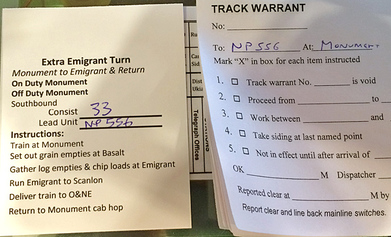
Before taking on my next assignment operating the Extra Emigrant Turn I was able to mingle and photograph a few of the trains out and running on the layout including NP Monument to Pasco train 660 (Paul Duncan), GN Salt Lake City to Portland passenger train No. 66 with SP&S equipment (Blair Kooistra), as well as Rio Grande Helper, UP to Centralia, WA coal train (Greg McComas). This interlude was brief as I was directed to Monument Yard to report for duty.
I was assigned a pair of NP GP7's, Nos. 556 and 567, to handle the Extra Emigrant Turn. GP7 556 sported roof-mounted air tanks. I hostled my own power from the engine service tracks at Monument Yard to to lead where the yard job had spotted my train of empty grain boxcars. All of these 40-foot boxcars are being repositioned for off-season storage. I then doubled this train onto a green NP caboose and was ready to depart after completing the required tests.
The mainline was busy so the train dispatcher was unable to let me out for a while. I made a shuffle move in the interim to allow a Great Northern transfer job to access Dayville yard. Eventually I was issued a track warrant to proceed from Monument to Snowline with and "X" in Box 4--"Take siding at last named point." The two GP7s handled the short train of empty boxcars nicely up the 2.2% grade to Snowline where we took siding to meet NP passenger train No. 8. This train was an consist of locomotives and cars in the NP two-tone green scheme and was a reminder of the class railroads had at the end of the passenger train era.
The railroad was pretty busy and it took some time after the meet with No. 8 to get a track warrant to proceed. In the interim NP train No. 8 had descended the grade to Dayville and had met NP freight train No. 653 which was powered by a pair of Santa Fe F45 locomotives on the head-end and a NP U25C on the rear as a helper. This train pulled adjacent to the Extra Emigrant Turn at Snowline an posed briefly for some side-by-side shots. Now with a warrant to Emigrant, the Extra Emigrant Turn departed Snowline as the helper locomotive was being cut off of train No. 653.
I was assigned a pair of NP GP7's, Nos. 556 and 567, to handle the Extra Emigrant Turn. GP7 556 sported roof-mounted air tanks. I hostled my own power from the engine service tracks at Monument Yard to to lead where the yard job had spotted my train of empty grain boxcars. All of these 40-foot boxcars are being repositioned for off-season storage. I then doubled this train onto a green NP caboose and was ready to depart after completing the required tests.
The mainline was busy so the train dispatcher was unable to let me out for a while. I made a shuffle move in the interim to allow a Great Northern transfer job to access Dayville yard. Eventually I was issued a track warrant to proceed from Monument to Snowline with and "X" in Box 4--"Take siding at last named point." The two GP7s handled the short train of empty boxcars nicely up the 2.2% grade to Snowline where we took siding to meet NP passenger train No. 8. This train was an consist of locomotives and cars in the NP two-tone green scheme and was a reminder of the class railroads had at the end of the passenger train era.
The railroad was pretty busy and it took some time after the meet with No. 8 to get a track warrant to proceed. In the interim NP train No. 8 had descended the grade to Dayville and had met NP freight train No. 653 which was powered by a pair of Santa Fe F45 locomotives on the head-end and a NP U25C on the rear as a helper. This train pulled adjacent to the Extra Emigrant Turn at Snowline an posed briefly for some side-by-side shots. Now with a warrant to Emigrant, the Extra Emigrant Turn departed Snowline as the helper locomotive was being cut off of train No. 653.
|
En route to Emigrant was the station of Basalt where we had orders to set out all of our boxcars for storage. After a quick switch move off the main track the Extra Emigrant Turn proceeded into Emigrant as a caboose-hop where the main line was cleared and the track warrant voided to the train dispatcher.
The task for the Extra Emigrant Turn at Emigrant was to gather all of the empty empty log cars and all of the loaded wood chip cars and build them into a Northbound train to operate back over the grade to Monument. As I was working the Hines Lumber Mill at Emigrant, NP train No. 653 passed by on the main with the two Santa Fe F45's with Paul Duncan at the throttle. There were a few nice photo opportunities of No. 653 passing through Emigrant. |
The Extra Emigrant Turn climbs the 2.2% grade to Snowline.
|
|
Nearing the end of this tour of duty, the Extra Emigrant Turn has yarded its train at the O&NE Scanlon Yard and prepares to grab its caboose for the short trip to the NP Monument Yard to tie-up.
|
After this train passed there was still a Great Northern Work Train to be met before being able to depart. This train, being operated by the illustrious Blair Kooistra, also had a set out to make at Basalt so I took the opportunity to ops-test...I mean photograph him working Basalt.
Track warrant in hand, the Extra Emigrant Turn finally headed back towards Monument. The cars on this train were not destined for the NP Monument Yard where the train originated, but rather for the Oregon and Northeastern (O&NE) Scanlon Yard just to the north of the NP Monument Yard. Upon arrival at the south end of Monument there were several trains waiting to depart, blocking the entrance to the yards. An operating decision was made and the Extra Emigrant Turn operated down the main past the north end of Monument. Once on single main track, the Turn made a saw move, backing towards the NP Monument Yard, and then pulling into the O&NE Scanlon Yard. |
The final move of the day after yarding the wood chip hoppers and log flats at Scanlon was to grab the caboose and operate one more time as a caboose-hop from the O&NE Scanlon Yard to the NP Monument Yard where the caboose was set out on the caboose track and the locomotives parked at the engine facility.
As each of the operators completed their tours of duty we congregated in the crew area. Paul Duncan was the last operator running and shortly he had his southbound Southern Pacific manifest train parked neatly in the South Staging Yard. This was a very enjoyable operating session. There were few technical difficulties, the car tab system worked very well, and most importantly, this was a collection of great operators to spend an evening with.
Dean Ferris meticulously created a stage that draws the audience into 1969 PNW railroading. On this stage today the drama, saga, and action of mountain railroading came to life. It was an outstanding show!
Paul Duncan, Blair Kooistra, Greg McComas and I carpooled together. It was good company to be with on the commute back to our rallying point at the Alliance Pilot.
As each of the operators completed their tours of duty we congregated in the crew area. Paul Duncan was the last operator running and shortly he had his southbound Southern Pacific manifest train parked neatly in the South Staging Yard. This was a very enjoyable operating session. There were few technical difficulties, the car tab system worked very well, and most importantly, this was a collection of great operators to spend an evening with.
Dean Ferris meticulously created a stage that draws the audience into 1969 PNW railroading. On this stage today the drama, saga, and action of mountain railroading came to life. It was an outstanding show!
Paul Duncan, Blair Kooistra, Greg McComas and I carpooled together. It was good company to be with on the commute back to our rallying point at the Alliance Pilot.
Appendix
Item I
Greg McComas did a write-up of his own experience at this operating session and posted it on his own Michigan Interstate Blog:
Greg McComas did a write-up of his own experience at this operating session and posted it on his own Michigan Interstate Blog:
Item II
An introduction to the NP-GN Oregon Joint Line by Dean Ferris:
An introduction to the NP-GN Oregon Joint Line by Dean Ferris:
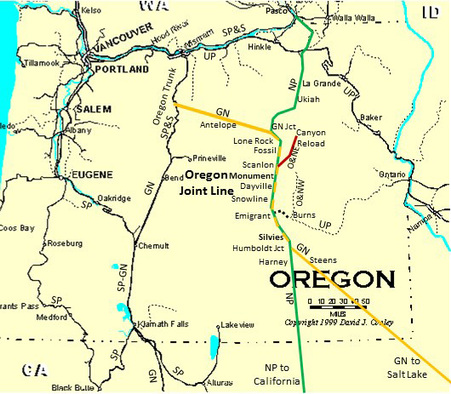
Set in 1969 just prior to the BN merger, the Oregon Joint Line is NP’s answer to the GN-WP Oregon Trunk/Inside Gateway line connecting the PNW and California. The line extends south from NP’s humpyard at Pasco through Eastern Oregon to connections with the WP-SP paired trackage lines through Nevada. GN also has a line cutting diagonally across eastern Oregon to gain access to the Salt Lake area. GN has trackage rights over the NP from GN Jct to Humboldt Jct over a stretch of track referred to as the Oregon Joint Line. The Oregon Joint line hosts plenty of run through pool power from WP, SP, ATSF, & DRGW. The GN routing from Salt Lake also sees DRGW Coal trains. Passenger service is an NP Seattle-Los Angeles train, a GN Portland-Salt Lake Train, and the Oregon Joint Line Mixed from Monument to Wishram.
Major terminal on the Oregon Joint Line is NP’s Monument Yard. Adjacent to the south is GN’s Dayville Yard, and to the north is Oregon & Northeastern’s Scanlon Yard. A primary feature of the Oregon Joint Line is the interaction between these yards. Another key feature is the helper operation south of Monument to Snowline on the 2.2% grade. The heaviest northbounds will also receive helpers from Silvies to Snowline. The Oregon & Northeastern is a timber industry shortline modeled after the Oregon Calfornia & Eastern and Oregon & Northwestern. The O&NE serves the paper and sawmill complex at Scanlon and also operates log trains from Canyon Reload. Basically the layout is a homage to my favorite railroad things – Santa Fe Hotshots, SP Boxcar/Lumber trains, Rio Grande Coal trains, Western regionals (WP, SP&S), Logging Railroads, and of course my home roads NP & GN.
Major terminal on the Oregon Joint Line is NP’s Monument Yard. Adjacent to the south is GN’s Dayville Yard, and to the north is Oregon & Northeastern’s Scanlon Yard. A primary feature of the Oregon Joint Line is the interaction between these yards. Another key feature is the helper operation south of Monument to Snowline on the 2.2% grade. The heaviest northbounds will also receive helpers from Silvies to Snowline. The Oregon & Northeastern is a timber industry shortline modeled after the Oregon Calfornia & Eastern and Oregon & Northwestern. The O&NE serves the paper and sawmill complex at Scanlon and also operates log trains from Canyon Reload. Basically the layout is a homage to my favorite railroad things – Santa Fe Hotshots, SP Boxcar/Lumber trains, Rio Grande Coal trains, Western regionals (WP, SP&S), Logging Railroads, and of course my home roads NP & GN.
Adjusted Variabes
|
Prototype Example
Oregon Trunk line thru Oregon SP Modoc Line towards Salt Lake BN-SP & BN-WP 1970’s pool OC&E & O&NW Oregon loggers Klamath Falls SP-GN-OC&E Oregon Trunk mixed until 1971 GN-SP Chemult-Klamath Falls |
Item III
Time-Lapse Slide Show of Monument Yard by Dean Ferris:
Time-Lapse Slide Show of Monument Yard by Dean Ferris:
Item IV
An introduction to the Car Tab car-forwarding system as well as the specifics of the system used by Dean Ferris on his NP Oregon Joint Line N-scale model Railroad.
Item V
The Columbia and Western is a well-known N-Scale railroad that uses a car-tab system. This YouTube video posted by the C&W's Mark Dance helps to explain how his system works. Car tag systems are more common in N-scale than HO-scale because N-scale car numbers are much smaller and more difficult for operators to read.
The Columbia and Western is a well-known N-Scale railroad that uses a car-tab system. This YouTube video posted by the C&W's Mark Dance helps to explain how his system works. Car tag systems are more common in N-scale than HO-scale because N-scale car numbers are much smaller and more difficult for operators to read.
